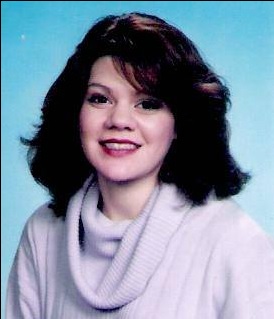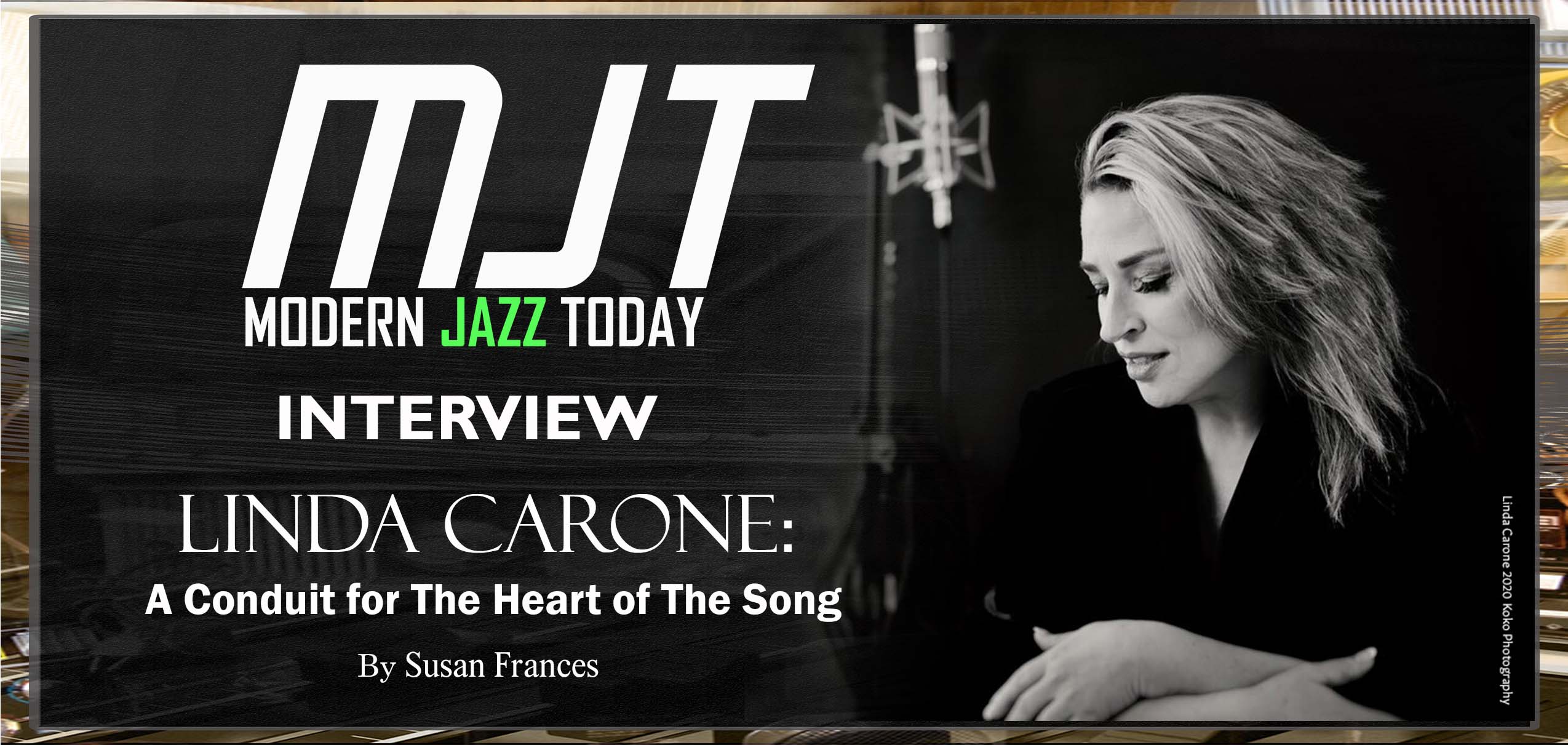Linda Carone: A Conduit for The Heart of The Song
By Susan Frances
Linda Carone’s musical journey begins as a collector of fine jazz, actively seeking a myriad of popular, rare, and sometimes risque vintage jazz tunes from the ’20s, ’30s, and ’40s. Her recordings canvass a broad range of jazz standards, cocktail swing, torch songs, boogie-woogie romps, and roots blues melodies.
An engaging crooner, Carone’s vocals affect audiences, bringing them in touch with the heart of the song. Her most recent release, her single “So Many Beautiful Men, So Little Time” is the followup to her 2017 debut recording Black Moonlight. Each leaving audiences wanting more.
She opens up, “I did not set out and choose to be a vocalist. After high school, I studied graphic design because I knew how to draw, and I was good at it, so the visual arts was a logical move for me. It wasn’t until the early 2000’s that I began singing. Over time, the songs and musical artists which inspired me was where I discovered that singing would be another way to express myself artistically.”
“Through my teens,” she recollects, “I was listening to the radio and absorbing everything from classic rock, hardcore punk to R&B and funk. It could be I was also influenced by vintage television, movie soundtracks, and TV jingles. My friend and roommate used to play Tom Waits and Billie Holiday records. It was Billie’s voice that ignited the songstress in me.”
Examining her attraction to jazz, she professes, “It was the feel and raw expression that I could relate to, and what led to digging deeper into the jazz vocal and the roots of blues music.”
Thus, her musical journey into jazz started. First collecting music from artists she enjoyed and then discovering her liking for the jazz style of expression.
“In Toronto,” she recalls, “there was a weekly program on CKLN college radio called ‘Sweet Patootie’ (Women in Blues, Gospel & Jazz). I recorded programs onto my cassette deck, so even though I was not singing at that time, I was collecting and learning about these artists and their songs, many of which were not very well known.”
“There was a great series of compilation albums on the Rosetta Records label,” she remembers. Listing some of her favorites as “Mean Mothers, Sweet Petunias, Boogie Blues, which were a great education into this forum.”
Her liking for jazz music grew into a passion that was so strong that she was moved to avail herself to singing. Compelled to be a conduit for the heart of a song, singing proved to be a natural extension of her self-expression.
“The stage was being set for me,” she determines, “as some of the songs stuck with me and are in my repertoire to this day. With each performance, I try to honor the artists and songwriters by sharing with the audience the things I’ve learned of the genre.”
Carone went through a learning curve before finding her stride. “My earliest musical experience that I recall,” she reveals, “was after a performance blunder. I had decided, at the ripe old age of five, that I would not continue to learn the piano. I don’t recall being encouraged, and so this remained with me. Because most of the fear surrounding singing,” she relates, “lay in the concept of performance. It was a great waste of time. However, I try to view it as being part of my unique journey.”
Once Carone distinguished between a piano performance and a vocal performance, her fears of being on stage waned. “One of the first moments someone heard me sing,” she discerns, “was while I was in the bathtub, and my boyfriend then said I sounded beautiful, and that was encouraging.”
She admits, “I never imagined I would be singing in front of people years down the road. I worked my way into it, slowly with meditations, chants, South Indian scales, and singing at home. I took a few vocal workshops, created a little visual mind map, and hit a few open mics followed by booking myself actual performances where I eventually conquered that fear of performing in front of an audience.”
Carone’s relationship with her audience is reciprocal. She leaves audiences beckoning her for more, and they encourage her to sing more.
She notes, “After years of developing my repertoire, I wanted to share my discovery of these songs that inspired me to sing. I thought the time is now, and so I focused on building my album concept on these songs that I love.”
Her debut recording Black Moonlight released in 2017, introduced audiences to her caressive and sensual vocals. In addition, the CD features her interpretation of “Livin’ My Life My Way,” a torch song written and sung by Helen Humes.
Carone brings the vintage track into the present as she proclaims,” ‘Livin’ My Life My Way’ was definitely one song I had to cover. I don’t know of any other versions besides Helen Hume’s, but I just felt it was a must.”
Other covers on the recording include Imelda May’s “Big Bad Handsome Man” and Jimmy Davis’s “Why Is A Good Man So Hard To Find.” She consigns, “I don’t know that I improved on any songs as I can only interpret them in my own way. I would rather listen to the original… the original to me can never be superseded, but the unfortunate thing about many of these beautiful and rare vintage songs are the poor quality in the recordings.”
“Modern recordings,” she imparts, “can certainly revive the music, but it doesn’t necessarily make it better. Helen Humes could sing anything. She was brilliant, and no one can touch her.” Carone raves, “She is one voice, one personality who is just so unique.”
Accompanying Carone on her debut recording are Mark Kieswetter on piano, George Koller on bass, Davide DiRenzo on drums, Ted Quinlan on guitar, John Johnson on bass clarinet, and tenor saxophone, and Ron Westray on trombone. Together, Carone and company accomplish reviving these rare gems with a contemporary glint.
She provides, “I knew of all the musicians from the jazz scene in Toronto before I recorded but hadn’t worked with most of them. I had approached George Koller to wield his producer talents to assemble some brilliant musicians into the studio.”
In her most recent release, “So Many Beautiful Men, So Little Time,” she explains that it is a lesser-known tune with a great feel and fun lyrics. I knew of a couple of musicians that I wanted on this FACTOR-funded recording, so again George Koller stepped in to help produce the single. I had a lead sheet arrangement which gave us room to improvise, and all the musicians brought their own unique flavour to the project.”
Supporting Carone on the single are Jeremy Ledbetter on piano, George Koller on bass, Luis Orbegosa on percussion, Ben Wittman on drums, and Perry White on saxophone. The band brings out the lush textures in her vocals, moving in sync with Carone’s rhythmic pace.
Applauding the pool of musicians accessible to her, Carone cites, “We have an abundance of musical talent here in Toronto. Not only are they first-rate, hardworking, and in demand, they bring their skills and professionalism into the recording studio. Jeremy, Luis, Ben, and Perry, who I had never worked with before, made it easy, and they are ALL super nice guys. George works with and knows almost everyone. It was an absolute blast!”
Their performance enhances the flirtatious lilt in her vocals and amplifies the bluesy intonations of her register. She remarks about her vocal style, “I do think that everyone can relate to the blues, although the definition of the blues varies depending who you talk to. I don’t know if I would narrow myself to solely being a ‘blues’ singer, and there are different types of blues developed in various parts of the U.S., like Chicago, Delta, etc., but blues also come from different parts of the world too, i.e., Africa. I do believe there is room for the blues… in everyone.”
When choosing her setlist for live performances, Carone uses her instincts. “I try to feel out a venue’s vibe,” she describes, “along with how I’m feeling, and then I’ll sort out a setlist for the occasion. I work with different musicians based on the venue. For example, if there is a piano, I’ll bring a pianist. It depends.”
“Before a show,” she considers, “I’ll run through the songs to sense the flow, how I’m feeling about it, how my voice is feeling, and then I’ll do a vocal warm-up on the day of the show in comparison to singing in the studio,” she weighs. “There is more of a last-minute fuss about it with a live performance, but live gigs give me a reason to put on a bit of lippy.” Lippy, in the sense that she accentuates the sensuality in the lyric, which she achieves naturally.
When she isn’t performing or working on her music, Linda Carone observes that some of her favorite pastime activities include, “Design, visual arts, illustration, painting, creativity are what I’m doing when not singing and between all that I do enjoy my nature walks.”
“There certainly was a time when I couldn’t have imagined I’d be performing,” she acknowledges, “let alone recording music with top musicians.”
“I followed through on my passion,” she asserts, “small slow steps over a long period. It really was something I wanted to do for myself, and I am so glad that I made the decision to follow through. The bonus is others enjoy listening to me and take interest in what I have to bring to the stage.”
“I’ve met some lovely people along the way,” she highlights. “Some who have similar interests and who have been supportive. A little encouragement can make a big difference. For some people, it’s easy, but for others, it takes time to develop. Currently, I’m now looking towards 2022 with a new album project in mind.”
Carone’s relationship with her audience is entirely reciprocal. The more she gives audiences her own interpretation of long-forgotten gems, the more her audiences want to hear her interpretation of long-forgotten gems. Likewise, her vocals affect audiences instantly, bringing them closer to the heart of the song, leaving them wanting more each time.
About Susan Frances:
 Born in Brooklyn, New York and raised in eastern Long Island, I always enjoyed writing and made several contributions to my high school literary magazine, The Lion’s Pen. Influenced by writers of epic novels including Colleen McCullough and James Clavell, I gravitated to creative writing. After graduating from New York University with a BA in Liberal Arts, I tried my hand at conventional jobs but always returned to creative writing. Since 1998, I have been a freelance writer and have over three thousand articles to various e-zines including: Jazz Times, Blogcritics, Yahoo Voices, Goodreads.com, Authors and Books (books.wiseto.com), TheReadingRoom.com, Amazon.com, Epinions.com, Fictiondb.com, LibraryThing.com, BTS emag, BarnesandNoble.com, RomanticHistoricalReviews.com, AReCafe.com, Hybrid Magazine, and BookDepository.com. In 2013 and 2014, I was a judge in the Orange Rose Writing Competition sponsored by the Orange County chapter of the Romance Writers of America located in Brea, California.
Born in Brooklyn, New York and raised in eastern Long Island, I always enjoyed writing and made several contributions to my high school literary magazine, The Lion’s Pen. Influenced by writers of epic novels including Colleen McCullough and James Clavell, I gravitated to creative writing. After graduating from New York University with a BA in Liberal Arts, I tried my hand at conventional jobs but always returned to creative writing. Since 1998, I have been a freelance writer and have over three thousand articles to various e-zines including: Jazz Times, Blogcritics, Yahoo Voices, Goodreads.com, Authors and Books (books.wiseto.com), TheReadingRoom.com, Amazon.com, Epinions.com, Fictiondb.com, LibraryThing.com, BTS emag, BarnesandNoble.com, RomanticHistoricalReviews.com, AReCafe.com, Hybrid Magazine, and BookDepository.com. In 2013 and 2014, I was a judge in the Orange Rose Writing Competition sponsored by the Orange County chapter of the Romance Writers of America located in Brea, California.









No Comments